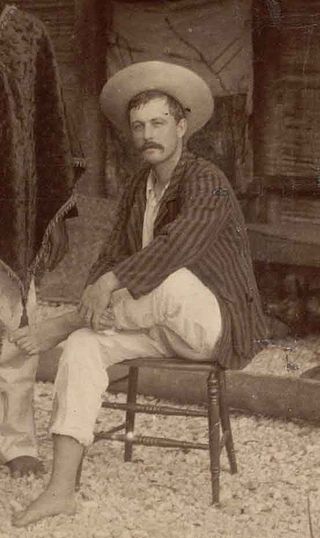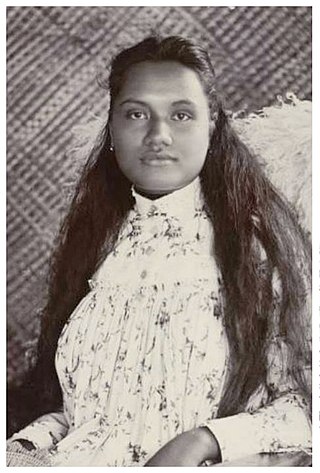
Robert Louis Stevenson was a Scottish novelist, essayist, poet and travel writer. He is best known for works such as Treasure Island, Strange Case of Dr Jekyll and Mr Hyde, Kidnapped and A Child's Garden of Verses.

The Samoan Islands were first settled some 3,500 years ago as part of the Austronesian expansion. Both Samoa's early history and its more recent history are strongly connected to the histories of Tonga and Fiji, nearby islands with which Samoa has long had genealogical links as well as shared cultural traditions.

Apia is the capital, largest, and only city of Samoa. It is located on the central north coast of Upolu, Samoa's second-largest island. Apia falls within the political district (itūmālō) of Tuamasaga.

Upolu is an island in Samoa, formed by a massive basaltic shield volcano which rises from the seafloor of the western Pacific Ocean. The island is 75 kilometres long and 1,125 square kilometres in area, making it the second largest of the Samoan Islands by area. With approximately 145,000 inhabitants, it is by far the most populous of the Samoan Islands. Upolu is situated to the southeast of Savai'i, the "big island". Apia, the capital, is in the middle of the north coast, and Faleolo International Airport at the western end of the island. The island has not had any historically recorded eruptions, although there is evidence of three lava flows, dating back only to between a few hundred and a few thousand years ago.

German Samoa was a German protectorate from 1900 to 1920, consisting of the islands of Upolu, Savai'i, Apolima and Manono, now wholly within the Independent State of Samoa, formerly Western Samoa. Samoa was the last German colonial acquisition in the Pacific basin, received following the Tripartite Convention signed at Washington on 2 December 1899 with ratifications exchanged on 16 February 1900. It was the only German colony in the Pacific, aside from the Jiaozhou Bay Leased Territory in China, that was administered separately from German New Guinea.

Frances Matilda Van de Grift Osbourne Stevenson was an American magazine writer. She became a supporter and later the wife of Robert Louis Stevenson, and the mother of Isobel Osbourne, Samuel Lloyd Osbourne, and Hervey Stewart Osbourne.

Siaosi ʻAlipate Halakilangi Tau’alupeoko Vaea Tupou, more commonly known as Baron Vaea, was a Tongan politician who served as Prime Minister of Tonga. Vaea was a nephew of Queen Sālote, who ruled Tonga from 1918 until 1965, and a member of the Tongan nobility. His career in the Tongan government spanned 54 years.

The O le Ao o le Malo is the head of state of Samoa. The position is described in Part III of the 1960 Samoan constitution. At the time the constitution was adopted, it was anticipated that future heads of state would be chosen from among the four Tama a 'Aiga "matai" paramount chiefs in line with customary protocol. This is not a constitutional requirement, so Samoa can be considered a parliamentary republic rather than a constitutional monarchy. The government Press Secretariat describes Head of State as a "ceremonial president". The holder is given the formal style of Highness, as are the heads of the four paramount chiefly dynasties.

Joseph Dwight Strong, Jr. (1853–1899) was an American artist and illustrator, known for his paintings. He was active between 1870s until 1899, in the San Francisco Bay Area, Monterey, Kingdom of Hawaii, and Samoa.
Rex Maughan was an American businessman. He was the founder, president, and chief executive officer of Forever Living Products, superseded by his son Gregg Maughan in the position of CEO. Forever Living is a multi-level marketing company that sells aloe vera and bee hive-based cosmetics and other personal products.

A Footnote to History: Eight Years of Trouble in Samoa is an 1892 historical non-fiction work by Scottish-born author Robert Louis Stevenson describing the contemporary Samoan Civil War.

Thomas Andrew was a New Zealand photographer who lived in Samoa from 1891 until his death in 1939.

Stevenson Memorial is a 1903 oil painting by the American artist Abbott Handerson Thayer, intended to commemorate the writer Robert Louis Stevenson. Though Thayer initiated several paintings with the intent of honoring Stevenson, Stevenson Memorial is the only version to survive the artist's revisions.

Mount Vaea is a 472 m summit overlooking Apia, the capital of Samoa located on the north central coast of Upolu island. The mountain is situated south about 3 km inland from Apia township and harbour. The settlement at the foothills on the northern side of the mountain is called Lalovaea.

Isobel "Belle" Osbourne Strong Field was a writer and the daughter of Fanny Stevenson and sister of Lloyd Osbourne. Through her mother's second marriage, she was a stepdaughter of Robert Louis Stevenson.

John Wilberforce "Jack" Buckland (1864–1897), also known as "Tin Jack", was a trader who lived in the South Pacific in the late 19th century. He travelled with Robert Louis Stevenson and his stories of life as an island trader became the inspiration for the character of Tommy Hadden in The Wrecker (1892).

Tui Manu'a Matelita, born Margaret Young, and also known as Makelita, Matelika or Lika was the Tui Manu'a of Manu'a, a group of islands in the eastern part of the Samoan Islands, from 1891 to 1895. During her tenure, she served largely a ceremonial role at her residence on Ta'ū where she received British writer Robert Louis Stevenson. Matelita never married because she would not marry any of the eligible native chieftains and no other men were regarded as having the proper rank to marry her. She died of illness in 1895, although later reports claimed she died by a more violent means. She was buried in the Tui Manu'a Graves Monument.
Tusitala is a 1986 three-part mini series for television based on the last years in the life of Robert Louis Stevenson, when he left Great Britain for Sydney and west Samoa.

The Robert Louis Stevenson Museum is a museum in Samoa, which commemorates the life of the Scottish author Robert Louis Stevenson. The museum displays a curated version of his residence, as Stevenson lived in it. Its establishment was funded by overseas donations.




















